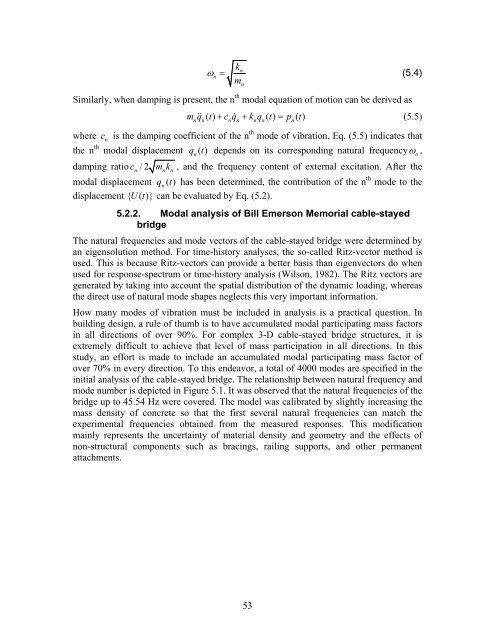Assessment of the Bill Emerson Memorial Bridge - FTP Directory ...
Assessment of the Bill Emerson Memorial Bridge - FTP Directory ...
Assessment of the Bill Emerson Memorial Bridge - FTP Directory ...
- No tags were found...
You also want an ePaper? Increase the reach of your titles
YUMPU automatically turns print PDFs into web optimized ePapers that Google loves.
knω = (5.4)nm nSimilarly, when damping is present, <strong>the</strong> n th modal equation <strong>of</strong> motion can be derived asm nq&& n() t + c nq& n+ k nq n() t = pn () t(5.5)where c is <strong>the</strong> damping coefficient <strong>of</strong> <strong>the</strong> n mode <strong>of</strong> vibration. Eq. (5.5) indicates thatn<strong>the</strong> n th modal displacement q tn ( ) depends on its corresponding natural frequencyω n ,damping ratio cnth/2 m k n, and <strong>the</strong> frequency content <strong>of</strong> external excitation. After <strong>the</strong>nmodal displacement q (t) has been determined, <strong>the</strong> contribution <strong>of</strong> <strong>the</strong> n thnmode to <strong>the</strong>displacement {U( t)} can be evaluated by Eq. (5.2).5.2.2. Modal analysis <strong>of</strong> <strong>Bill</strong> <strong>Emerson</strong> <strong>Memorial</strong> cable-stayedbridgeThe natural frequencies and mode vectors <strong>of</strong> <strong>the</strong> cable-stayed bridge were determined byan eigensolution method. For time-history analyses, <strong>the</strong> so-called Ritz-vector method isused. This is because Ritz-vectors can provide a better basis than eigenvectors do whenused for response-spectrum or time-history analysis (Wilson, 1982). The Ritz vectors aregenerated by taking into account <strong>the</strong> spatial distribution <strong>of</strong> <strong>the</strong> dynamic loading, whereas<strong>the</strong> direct use <strong>of</strong> natural mode shapes neglects this very important information.How many modes <strong>of</strong> vibration must be included in analysis is a practical question. Inbuilding design, a rule <strong>of</strong> thumb is to have accumulated modal participating mass factorsin all directions <strong>of</strong> over 90%. For complex 3-D cable-stayed bridge structures, it isextremely difficult to achieve that level <strong>of</strong> mass participation in all directions. In thisstudy, an effort is made to include an accumulated modal participating mass factor <strong>of</strong>over 70% in every direction. To this endeavor, a total <strong>of</strong> 4000 modes are specified in <strong>the</strong>initial analysis <strong>of</strong> <strong>the</strong> cable-stayed bridge. The relationship between natural frequency andmode number is depicted in Figure 5.1. It was observed that <strong>the</strong> natural frequencies <strong>of</strong> <strong>the</strong>bridge up to 45.54 Hz were covered. The model was calibrated by slightly increasing <strong>the</strong>mass density <strong>of</strong> concrete so that <strong>the</strong> first several natural frequencies can match <strong>the</strong>experimental frequencies obtained from <strong>the</strong> measured responses. This modificationmainly represents <strong>the</strong> uncertainty <strong>of</strong> material density and geometry and <strong>the</strong> effects <strong>of</strong>non-structural components such as bracings, railing supports, and o<strong>the</strong>r permanentattachments.53
















